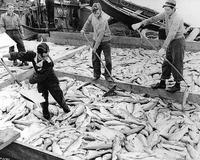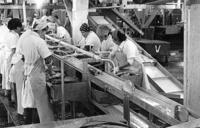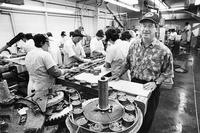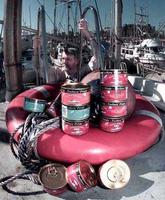Salmon Canning
SALMON CANNING in BC began on the FRASER R near NEW WESTMINSTER in 1867, when James SYME opened the first cannery in an abandoned saltery. His operation failed, but 2 others begun in the same vicinity in 1871 succeeded in launching a permanent industry. By 1881 there were 10 canneries on the Fraser, exporting 142,516 cases of fish. For the most part they concentrated at STEVESTON and LADNER near the mouth of the river. Canneries spread up the coast as well; the first opened on the SKEENA R in 1876, the NASS R in 1881 and in RIVERS INLET in 1882. Competition was chaotic and in 1902 BC PACKERS was created to merge and rationalize many of the operations.
Canneries were supplied by a fleet of rowed fishing boats using gillnets in the lower reaches of the rivers (see FISHING, COMMERCIAL). Initially most of the fishers were FIRST NATIONS people from coastal villages, though by 1900 the fleet was mainly JAPANESE and white. Inside the canneries, workers were aboriginal women and CHINESE. They were hired by labour contractors for the canning season, which ran from Mar, when cans were manufactured, to Sept, when the last fish were processed. Workers lived in meagre accommodation provided by the canneries, segregated by race. Fish were butchered, cleaned, cut into pieces and packed in tin cans, all by hand. After tops were soldered on, the cans were cooked in steam retorts, then labelled and shipped. Gradual mechanization (with, for example, the IRON CHINK) reduced the number of workers and increased the productivity of the canneries. The industry was extremely wasteful: initially it only processed chinook and sockeye; other species caught in the nets were killed and thrown away. As well, when the supply was so plentiful that the canning lines could not keep up, the excess was discarded. Public complaints caused the government to step in to regulate the industry (see FISHERIES POLICY).
From about 1905, new markets opened for pink and chum salmon, encouraging the geographical expansion of the industry. The number of operating canneries peaked at 80 in 1918; in total there were 223 cannery sites on the coast. The Fraser and Skeena rivers always had the highest concentration of canneries, though canning took place in many other locations. Production of canned salmon peaked during the 1920s at about 2 million cases annually. With the onset of the Depression the industry began to consolidate and the number of canneries declined steadily. Freezing technology was introduced after WWII, and plants diversified their product lines to stay open year-round. At this time the market for canned fish, much of which had been British, became mainly domestic. Further closures took place in the late 1960s and surviving plants centralized at PRINCE RUPERT and the VANCOUVER area. The CANADIAN FISHING CO cannery at Prince Rupert (owned by BC Packers until 1999) is the world's largest salmon cannery. There are now fewer canneries than frozen-fish processors. In 2004 canned salmon production totalled 552,707 cases worth $60 million and canned salmon accounted for less than 40% of the total wholesale value of BC's salmon products, down from 80% in 1955. Specialty markets for frozen, fresh, smoked and salted fish account for the rest. In 2004 there were 7 salmon canneries and 239 fish processing plants operating in BC, concentrated in the Lower Mainland, VANCOUVER ISLAND and Prince Rupert. Along with salmon canning, these processing plants include shellfish processing and fish processing of all types.
Reading: M. Patricia Marchak et al, eds, Uncommon Property: The Fishing and Fish-Processing Industries in BC, 1987.




